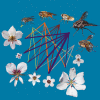Pollination syndrome accurately predicts pollination by tangle-veined flies (Nemestrinidae: Prosoeca s.s.) across multiple plant families
- PMID: 35975653
- PMCID: PMC9804979
- DOI: 10.1111/plb.13461
Pollination syndrome accurately predicts pollination by tangle-veined flies (Nemestrinidae: Prosoeca s.s.) across multiple plant families
Abstract
The idea that a syndrome of floral traits predicts pollination by a particular functional group of pollinators remains simultaneously controversial and widely used because it allows plants to be rapidly assigned to pollinators. To test the idea requires demonstrating that there is an association between floral traits and pollinator type. I conducted such a test in the Cape Floristic Region of South Africa, by studying the pollination of eight plant species from six families that flower in spring and have scentless, actinomorphic, upwards-facing flowers, with orbicular petals all held in the same plane. The petals are brilliant-white with red-purple nectar guides. The tubes are short and hold small volumes of concentrated nectar, except in the rewardless Disa fasciata (Orchidaceae). Pollinators were photographed and captured, pollen loads were analysed and pollination networks were constructed. Consistent with the pollination syndrome hypothesis, the species with the defined syndrome shared a small group of pollinators. The most frequent pollinators belonged to a clade of four tangle-veined fly species with relatively short proboscises (Nemestrinidae: Prosoeca s.s.), while functionally similar Bombyliidae and Tabanidae played minor roles. Among the four Prosoeca species, only Prosoeca westermanni has been described, a result that highlights our ignorance about pollinators. The demonstration of an association between the syndrome of traits and pollination by this group of flies explains the repeated evolution of the syndrome across multiple plant families, and allows prediction of pollinators in additional species. More generally, the result validates the idea that the traits of organisms determine their ecology.
Keywords: Adenandra; Fynbos vegetation; Stuckenbergina africana; coevolution; convergent evolution; floral deception; long-proboscid flies.
© 2022 The Authors. Plant Biology published by John Wiley & Sons Ltd on behalf of German Society for Plant Sciences, Royal Botanical Society of the Netherlands.
Figures






Similar articles
-
Biomechanics of nectar feeding explain flower orientation in plants pollinated by long-proboscid flies.Naturwissenschaften. 2022 Aug 27;109(5):47. doi: 10.1007/s00114-022-01817-6. Naturwissenschaften. 2022. PMID: 36029364
-
Flower orientation and corolla length as reproductive barriers in the pollinator-driven divergence of Erica shannonea and Erica ampullacea.Plant Biol (Stuttg). 2023 Dec;25(7):1083-1090. doi: 10.1111/plb.13575. Epub 2023 Sep 7. Plant Biol (Stuttg). 2023. PMID: 37676744
-
Matching floral and pollinator traits through guild convergence and pollinator ecotype formation.Ann Bot. 2014 Jan;113(2):373-84. doi: 10.1093/aob/mct203. Epub 2013 Sep 19. Ann Bot. 2014. PMID: 24052557 Free PMC article.
-
Mechanisms and evolution of deceptive pollination in orchids.Biol Rev Camb Philos Soc. 2006 May;81(2):219-35. doi: 10.1017/S1464793105006986. Biol Rev Camb Philos Soc. 2006. PMID: 16677433 Review.
-
Why are there so many bee-orchid species? Adaptive radiation by intra-specific competition for mnesic pollinators.Biol Rev Camb Philos Soc. 2020 Dec;95(6):1630-1663. doi: 10.1111/brv.12633. Epub 2020 Sep 21. Biol Rev Camb Philos Soc. 2020. PMID: 32954662 Review.
Cited by
-
Pollen transfer efficiency in Erica depends on type of pollinator.PhytoKeys. 2024 Jul 23;244:237-248. doi: 10.3897/phytokeys.244.107288. eCollection 2024. PhytoKeys. 2024. PMID: 39086738 Free PMC article.
-
Eco-evolutionary origins and diversification in a megadiverse hotspot: Arthropods in the Greater Cape Floristic Region.Ecol Evol. 2024 Aug 16;14(8):e70195. doi: 10.1002/ece3.70195. eCollection 2024 Aug. Ecol Evol. 2024. PMID: 39157666 Free PMC article. Review.
-
Evidence for moth pollination in a rhinomyiophilous Erica species from the Cape Floristic Region of South Africa.PhytoKeys. 2024 Sep 2;246:43-70. doi: 10.3897/phytokeys.246.126310. eCollection 2024. PhytoKeys. 2024. PMID: 39257487 Free PMC article.
-
Adaptation to pollination by fungus gnats underlies the evolution of pollination syndrome in the genus Euonymus.Ann Bot. 2023 Oct 18;132(2):319-333. doi: 10.1093/aob/mcad081. Ann Bot. 2023. PMID: 37610846 Free PMC article.
References
-
- Amorim M.D., Maruyama P.K., Baronio G.J., Azevedo C.S., Rech A.R. (2022) Hummingbird contribution to plant reproduction in the rupestrian grasslands is not defined by pollination syndrome. Oecologia, 199, 1–12. - PubMed
-
- Anderson B., Johnson S.D. (2008) The geographical mosaic of coevolution in a plant‐pollinator mutualism. Evolution, 62, 220–225. - PubMed
-
- Beattie A.J. (1971) A technique for the study of insect‐borne pollen. Pan‐Pacific Entomologist, 47, 82.
-
- Bilbao G., Bruneau A., Joly S. (2021) Judge it by its shape: a pollinator‐blind approach reveals convergence in petal shape and infers pollination modes in the genus Erythrina . American Journal of Botany, 108, 1716–1730. - PubMed
-
- Blondel J. (2003) Guilds or functional groups: does it matter? Oikos, 100, 223–231.
MeSH terms
Substances
LinkOut - more resources
Full Text Sources

